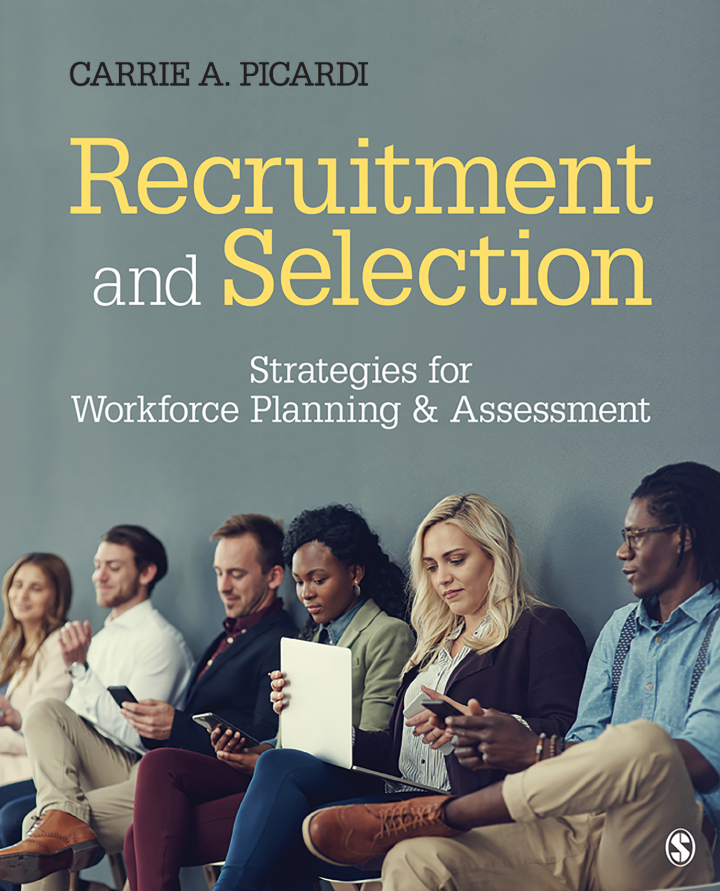
Recruitment and Selection 1st Edition Strategies for Workforce Planning & Assessment
PUBLISHER: Sage
Trường ĐH, Nhóm, Thư Viện: Gọi 0915920514 để báo giá Pearson, Vital Source eBook hoặc mua Sách In
Lực lượng lao động đang thay đổi và việc quản lý nhân tài trở nên quan trọng hơn bao giờ hết. Tuyển dụng và tuyển chọn: Các chiến lược lập kế hoạch và đánh giá lực lượng lao động đưa ra các phương pháp hay nhất để thiết kế, thực hiện và đánh giá các chiến lược tuyển dụng đúng người. Sử dụng khung phân tích công việc đã được chứng minh, tác giả Carrie A. Picardi sử dụng kinh nghiệm học thuật và ngành nghề của mình để dạy sinh viên cách đánh giá ứng viên một cách chính xác, hợp pháp và có đạo đức. Với sự rõ ràng và phù hợp, cuốn sách này thực sự kết nối giữa lý thuyết và khái niệm với thực tiễn một cách hấp dẫn và sẽ mang lại lợi ích cho những sinh viên cần bắt tay vào quản lý thành công các nhu cầu và hoạt động của lực lượng lao động trong vô số môi trường chuyên nghiệp.
PrefaceAcknowledgmentsAbout the Author1 • Introduction to Workforce Planning and AssessmentWhat Is “Work”? The Organization of Work and JobsThe Evolution of Work StructureOrganizing the Work: Jobs and Job FamiliesThe Standard Occupational Classification SystemThe O*NET® Online DatabaseThe Logistics of WorkIndividual Work Versus Team-Based WorkWork ShiftsWork LocationStrategic Job Redesign and Its BenefitsJob EnlargementJob EnrichmentThe Role of Human Resources in Workforce Planning and AssessmentSustaining the Human Resources–Functional Manager PartnershipHR Role Requirements for Workforce Planning and AssessmentOrganizational Best Practices: Spotlight on Job Rotation at HSBCChapter SummaryKey Terms2 • Legal Compliance and Ethical ConsiderationsLegal Compliance in Workforce Employment DecisionsTitle VII of the Civil Rights Act of 1964The Civil Rights Act of 1991The Americans With Disabilities ActThe Age Discrimination in Employment ActThe Equal Pay ActThe Lilly Ledbetter Fair Pay ActThe Immigration Reform and Control Act of 1986Temporary Work Visa ProgramsU.S. Legislation and Equal Employment OpportunityThe Equal Employment Opportunity CommissionThe Office of Federal Contract Compliance ProgramsAffirmative ActionUniform Guidelines on Employee Selection Procedures of 1978Assessment of Legal Compliance in Workforce Employment DecisionsIdentifying Adverse Impact and Disparate TreatmentThe Four-Fifths RuleRemediating Adverse Impact and Disparate TreatmentIdentifying Bona Fide Occupational QualificationsEthical Employment ConsiderationsLegal Practice and Ethical Practices—Not Necessarily the SameOrganizational Best Practices: Embracing Workforce Diversity at MasterCardChapter SummaryKey Terms3 • Job Analysis and DesignPhase 1: Identify the Job to ExaminePhase 2: Determine Appropriate Information Sources and Collect Job-Related DataWhat type of information needs to be obtained?Who should be providing the information?What is the best method for gathering job-related information?Archival RecordsObservationEmployee Work Journals/RecordkeepingSubject-Matter ExpertsQuestionnairesInterviewsPhase 3: Organize and Analyze DataOrganizational Best Practices: Discovering Data in New Places—Job Analysis Leverages Social Networking ToolsChapter SummaryKey Terms4 • Job Description and Competency Model DevelopmentJob Descriptions in a Perfect WorldRecruitmentSelectionPerformance ManagementTraining and DevelopmentJob Description Structure and FormatJob TitleJob OverviewDepartment/FunctionReporting StructureFair Labor Standards Act Status/CategoryPay GradeWorking ConditionsEducational RequirementsExperience RequirementsKSAO RequirementsEssential Duties and ResponsibilitiesCompetency ModelsDeveloping a Competency ModelLominger CompetenciesOrganizational Best Practices: Examining Global Leader Competencies at McKinsey & CompanyChapter SummaryKey Terms5 • Job EvaluationThe Job Evaluation ProcessStep 1: Obtain Job KSAOs, Qualifications, Working Conditions, and Essential DutiesCompensable Job FactorsStep 2: Examine Compensable Factors Using the Rating/Weighting Evaluation MethodPoint-Factor Rating MethodFactor WeightsStep 3: Add Factor Points Together to Determine Overall Job ValueSpotlight on Hay Group—Pioneer in Job EvaluationDetermining Compensation Using Job Evaluation DataBenchmark Analysis ProcessComparison of Internal Job and Benchmark JobEstablishing Pay Grades Using Compensation Benchmark DataHandling Pay Anomalies: Red Circle and Green Circle RatesLegal and Ethical Considerations for Job EvaluationOrganizational Best Practices: Behind the Scenes of an Online Salary Survey—Payscale’s Data MethodologyComparable WorthChapter SummaryKey Terms6 • Recruitment StrategyFactors Affecting RecruitmentLabor Market Conditions and Demographic ShiftsOrganizational Reputation/ImageOrganizational CompetitionAvailable Recruitment ResourcesRecruitment Strategy: An Internal ApproachCommon Methods for Internal RecruitmentInternal PostingsEmployee ReferralsBenefits of Internal RecruitmentFor the OrganizationFor the Job CandidateChallenges of Internal RecruitmentRecruitment Strategy: An External ApproachCommon Methods for External RecruitmentOrganizational WebsitesNewspapers and PeriodicalsAgencies and Search FirmsSocial MediaDesigning a Compelling External Job PostingLocationJob TitleWorking Conditions and LogisticsRecruitment Legal and Ethical ConsiderationsOrganizational Best Practices: Groupon’s Innovative Recruitment and Its People BlogChapter SummaryKey Terms7 • Selection and Interview StrategyInterview Strategy and ProcessStructured InterviewsIndividual and Group In-Person InterviewsPhone InterviewsVideo InterviewsVideo Interview Success FactorsStructured Interview QuestionsOpen-Ended and Closed-Ended QuestionsBackground/Chronology QuestionsJob Knowledge QuestionsBehavior-Based/Experiential QuestionsSituation-Based QuestionsDeveloping Effective InterviewersCommon Interviewer ErrorsHalo EffectContrast ErrorInappropriate SubstitutesPrimacy and Recency EffectsInterview Rating and Evaluation FormLegal and Ethical Considerations in the Interview ProcessOrganizational Best Practices: A Holistic Interview Process at Whole Foods MarketChapter SummaryKey Terms8 • Selection: Simulations and Assessment CentersSimulationsTypes of Simulations: High Fidelity and Low FidelityDesigning and Implementing Simulation ExercisesEvaluating Candidate Performance on SimulationsAssessment CentersAssessment Center StructureAssessment Center LogisticsUse of AssessorsMaking the Case for Assessment Center ImplementationLegal and Ethical Considerations for Simulations and Assessment CentersOrganizational Best Practices: Spotlight on Vodafone’s Assessment Center StrategyChapter SummaryKey Terms9 • Selection: Employment TestingHistory of Testing in Occupational SelectionAssessment of Knowledge, Skills, and AbilitiesPersonality AssessmentThe Five-Factor Personality Trait Model (The Big Five)ExtroversionAgreeablenessEmotional StabilityOpenness to ExperienceConscientiousnessThe Myers-Briggs Type IndicatorIntroversion/Extroversion: I/ESensing/Intuitive: S/NThinking/Feeling: T/FJudging/Perceiving: J/PHonesty and Integrity AssessmentAdministration of Tests and AssessmentsHard-Copy (aka Paper and Pencil) TestsElectronic/Computer TestingComputer Adaptive TestsTest Score Interpretation for Selection Decision MakingCutoff ScoresScore BandingValidity and Reliability of Testing MeasuresValidityConstruct ValidityContent ValidityCriterion ValidityReliabilityTest-Retest ReliabilityAlternate/Parallel Forms ReliabilitySplit-Halves ReliabilityInter-Item ReliabilityInterrater ReliabilityLegal and Ethical Issues of Employment TestingLegal Challenges in TestingTitle VII of the Civil Rights Act of 1964Americans With Disabilities ActAge Discrimination in Employment ActEthical Challenges in TestingTypecasting/LabelingHonesty and Response Distortion (aka Faking)Lack of Assessment/Testing ExpertiseOrganizational Best Practices: Identifying Strengths and Talents, the Facebook WayChapter SummaryKey Terms10 • Making the Hire—Final Assessment of Candidate–Job FitBiodata and Application FormsThe Role of Application Forms in the Selection ProcessElements of a Job Application FormSpotlight on Technology: Implications of Using Social Media Content in Hiring DecisionsBackground ChecksWork History VerificationEducation History VerificationCriminal HistoryCredit CheckDriving RecordReference ChecksRecommendation/Reference LettersReference Checks Through Structured Phone/E-Mail QuestionsReference Checks Through Structured Online FormsPreemployment TestingMaking a Job OfferEmployment at WillA Final Word: Transitioning From Job Candidate to EmployeeOrganizational Best Practices: Technology-Driven Reference Checks? There’s an App for ThatChapter SummaryKey TermsAppendixGlossaryReferencesIndex















